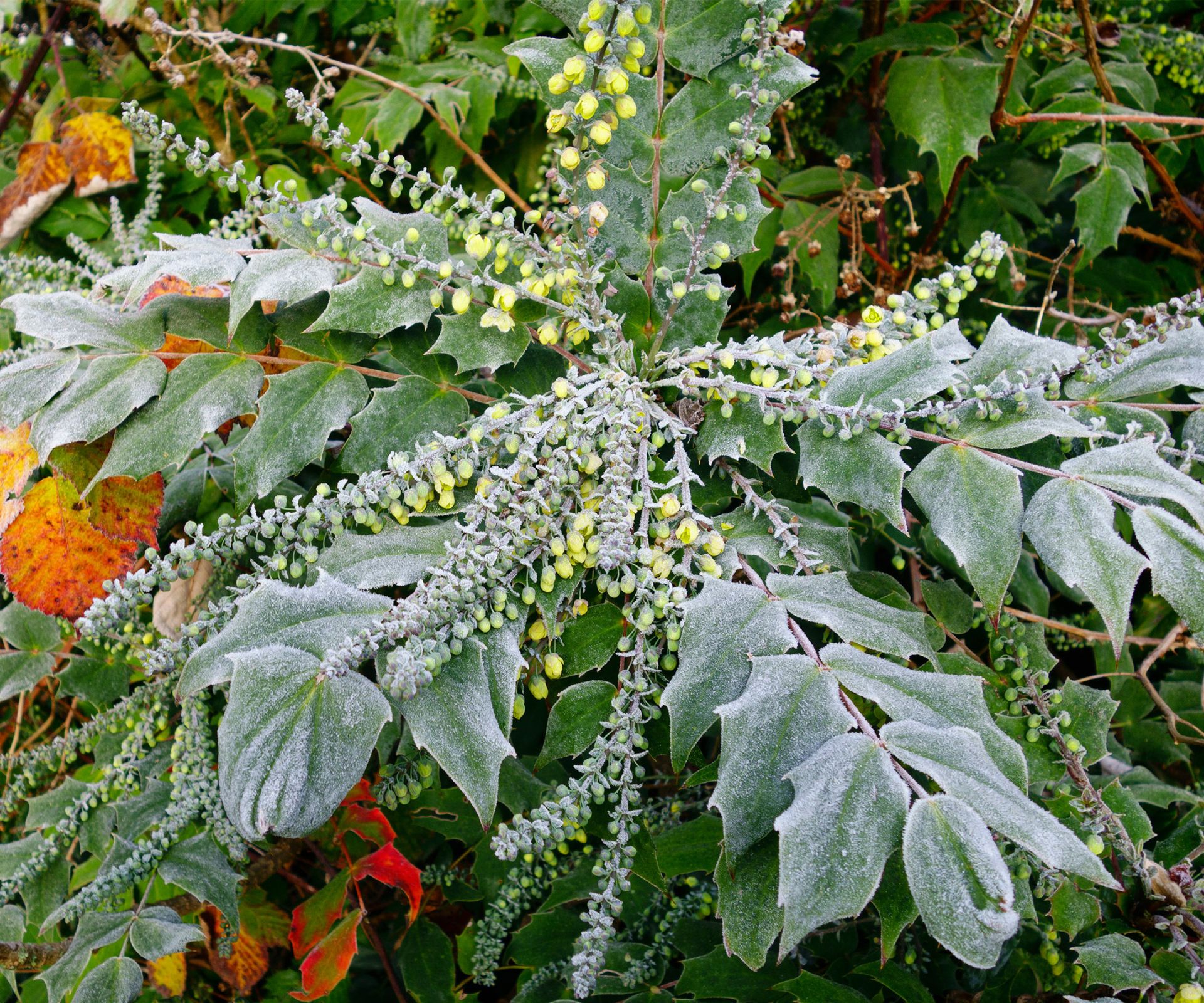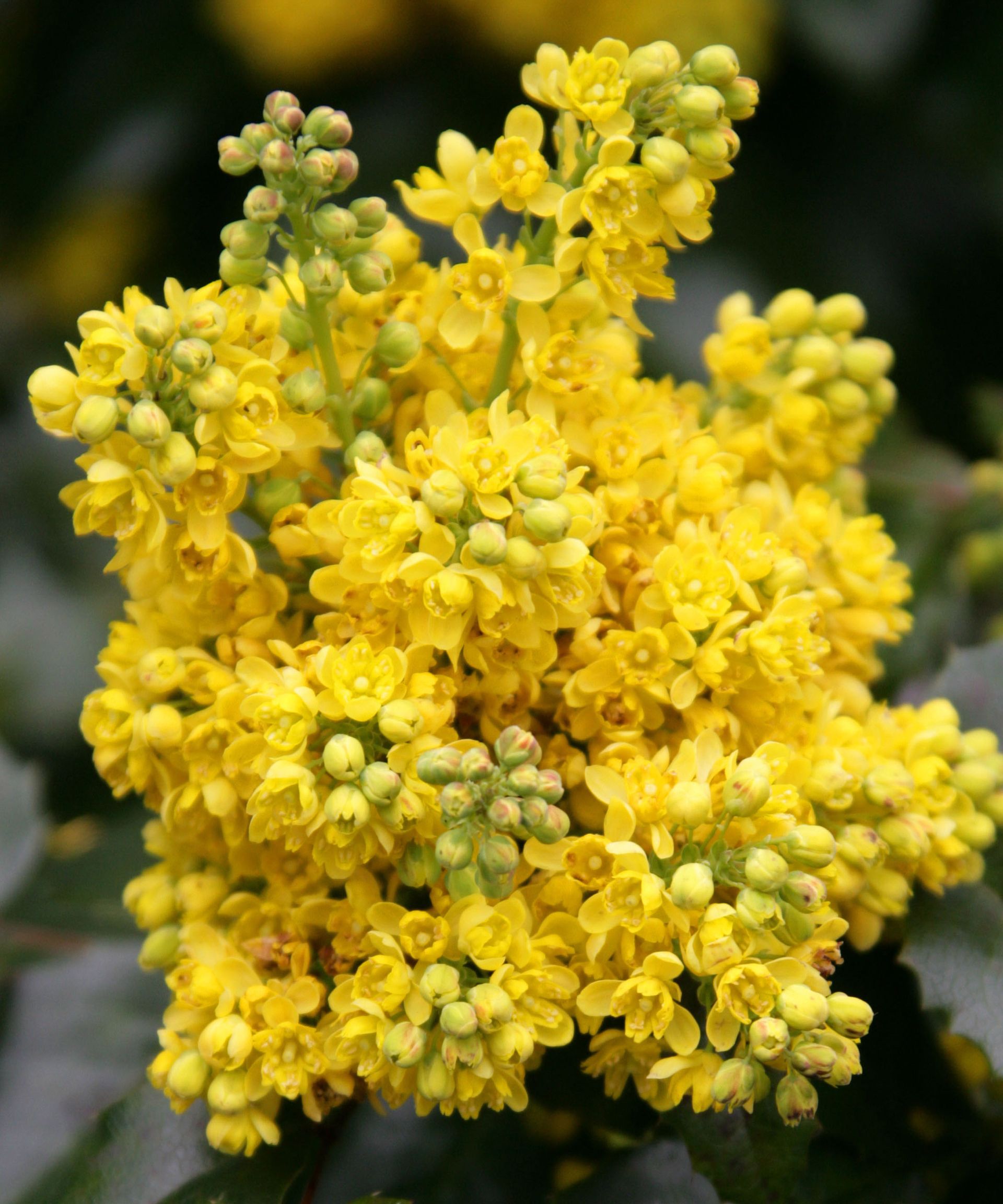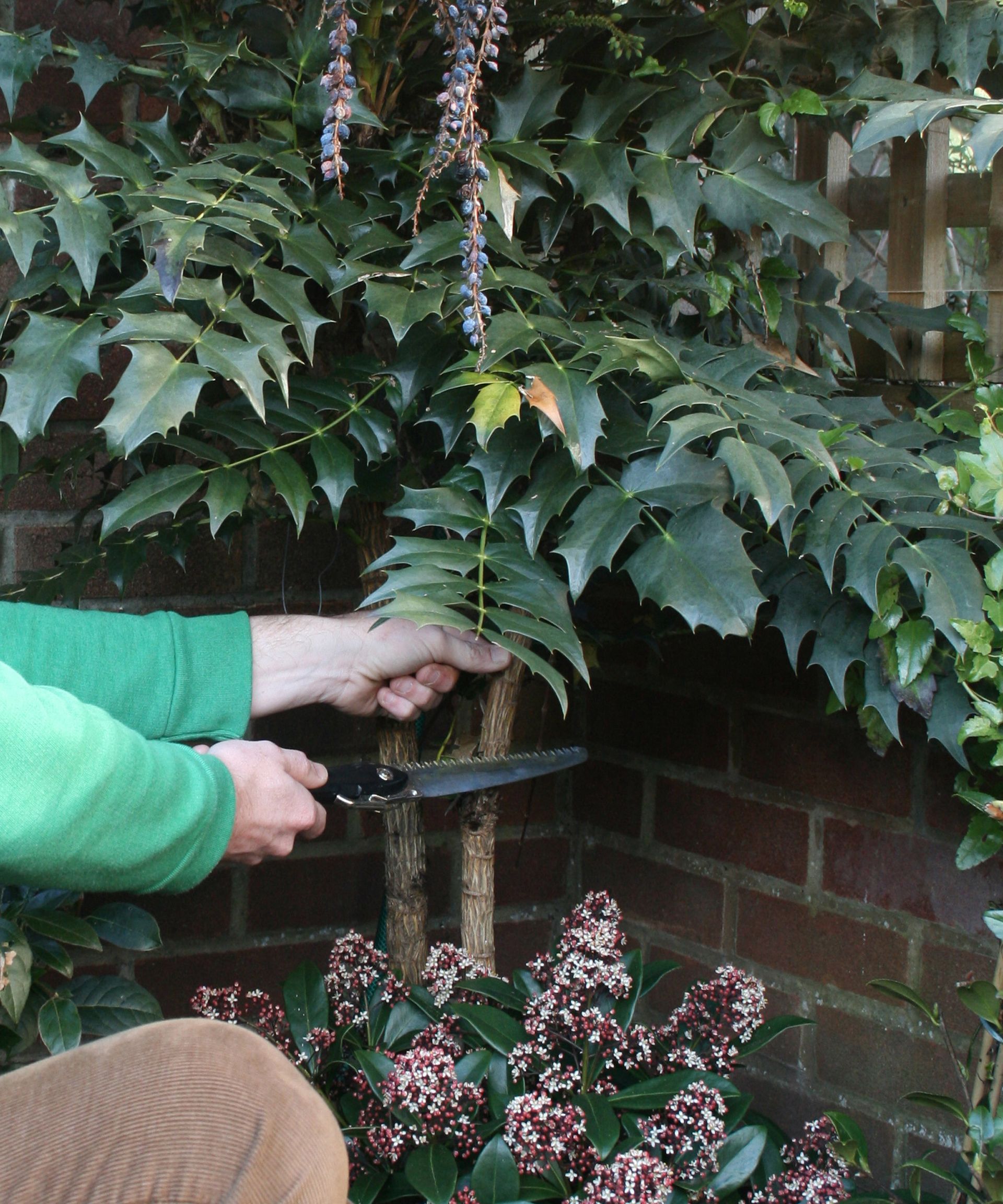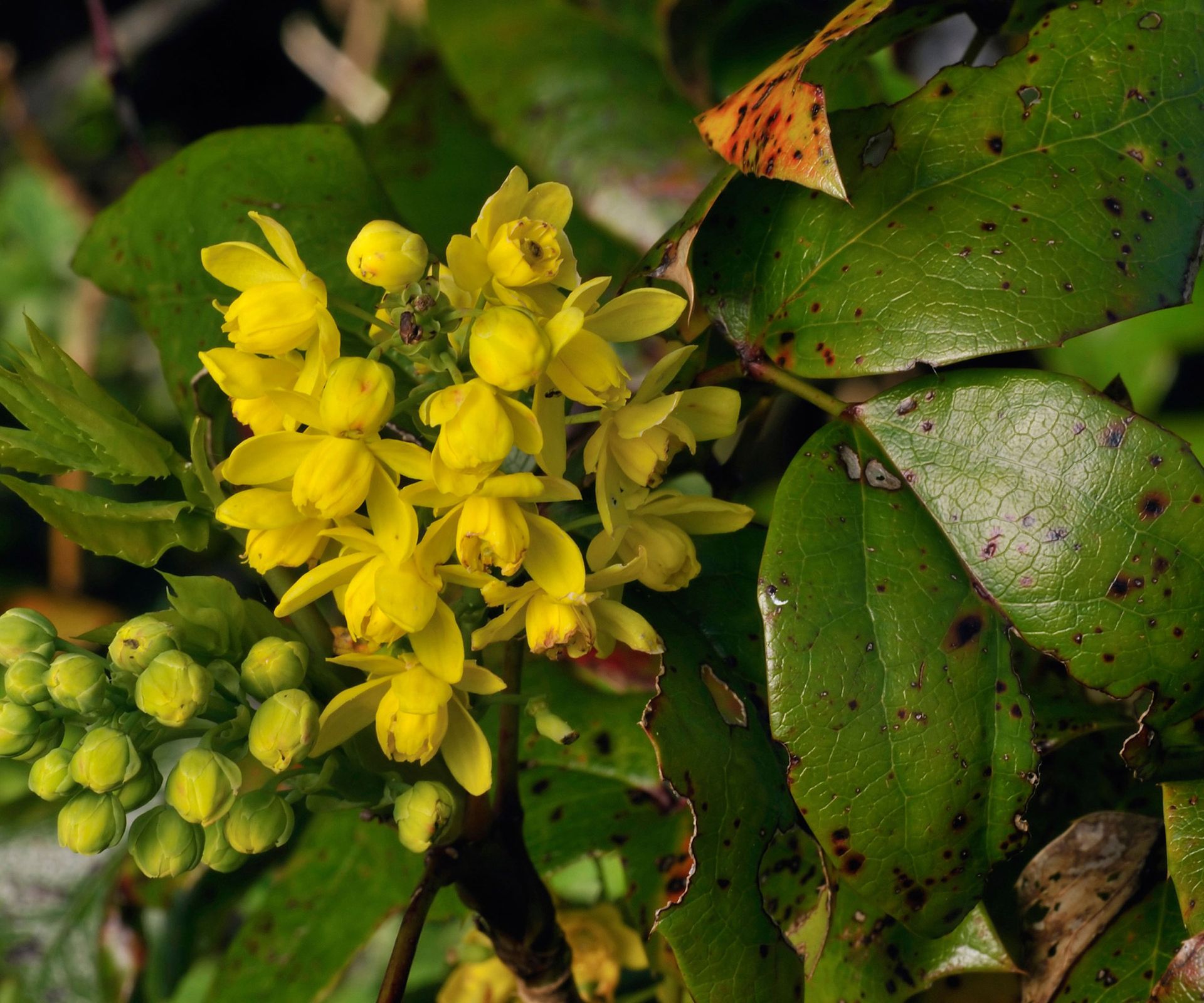Mahonia care and growing guide – expert tips for these evergreen shrubs
With its vibrant blooms and fragrant berries, mahonia is a versatile addition to any backyard planting scheme
- (opens in new tab)
- (opens in new tab)
- (opens in new tab)
- Sign up to our newsletter Newsletter


Mahonia are bold, evergreen shrubs featuring leathery leaves divided into segments, rather like those of a rose but on a larger scale. Their leaves are prickly along their edges, but the branches are thorn-free. These shrubs could be described as evergreen barberries, to which they are closely related. In fact, mahonias are sometimes recognized by botanists as so similar to the barberries (berberis) that they can’t be treated separately, so you may find them sold as berberis.
Their small, dainty, rounded and almost bell-like yellow flowers open in winter, spring or fall, depending on the variety. They are gathered in clusters or in fountains, or in arching spikes at the tips of the branches, sometimes opening from reddish buds. While many varieties present predominantly golden floral displays, varieties with orange flowers are increasingly seen. These flowers are followed by edible blue or black berries that are too acidic to eat raw but which, when cooked, make superb jams, jellies and wines.
Many make statuesque garden specimens, while others look impressive in borders with other evergreen shrubs. Some, like the Oregon grape (Mahonia aquifolium), the state flower of Oregon, make great weed-suppressing ground cover. They add structure and texture to all manner of borders, adding vibrancy to quiet corners and shady spots. And while they are traditionally associated with spring and winter, more fall-flowering varieties are now being introduced.

Dark blue berries of M. aquifolium (Oregon grape or holly-leaved barberry), invaluable when introduced as ground cover

Graham has a wealth of knowledge in all things horticulture. He trained at the prestigious Royal Botanic Gardens in Kew, England, and since then has written more than 20 books on plants and gardening. He gardened in Pennsylvania for 20 years, but has recently returned to his native England.
Mahonia key facts:
- Plant type: Evergreen shrub
- Mature size: 1-8ft (30cm-2m)
- Soil type: Moist, well-drained
- Soil PH: Acid, neutral, alkaline
- Time of year to plant: Spring, fall
- Flowering time: Winter, spring, fall
- Flower color: Yellow
- Fruit color: Blue-purple
- Hardiness zones: USDA Z5-7
- Scientific name: Mahonia
- Common name: Oregon grape, Mahonia, leatherleaf mahonia

Mahonia is also called leatherleaf mahonia on account of its distinctive hardy foliage which gives year-round interest
Mahonia flowering times
While a mahonia’s evergreen foliage adds energy to a quiet patch, its flowering potential is its most compelling and vibrant quality. 'The more this evergreen shrub crosses my path,' says shrub expert Michael Dirr in his Trees & Shrubs for Warm Climates (available from Amazon) (opens in new tab), 'the greater my appreciation of its floral attributes.'
Understanding when different varieties flower helps with selection and location. Mahonias can be conveniently divided into three groups, according to their flowering time.
- Winter-flowering For those looking for striking winter garden ideas, winter-flowering mahonias are vigorous, medium-sized or large evergreens that develop into striking year-round garden features thanks to their dramatic foliage. Their fragrant yellow flowers light up the winter garden. Most winter mahonias are varieties of Mahonia x media, although they may also be labelled M. bealei or M. japonica.
- Spring-flowering The good people at Nebraska’s Nature Hills nursery recommend the western native M. aquifolium, available online on their site (opens in new tab): 'Ornamental canary-yellow flowers cover the Oregon grape in spring. These massive clusters of vivid yellow flowers develop into picturesque dark blue berries,' says Nature Hills. 'Berries feature a steely blue, glaucous overcast and are held along long, downturned racemes for unmatched beauty.'
- Fall-flowering In recent decades, fall-flowering mahonias have begun to appear after a new species, M. eurybracteata, was introduced from China. Those usually seen are generally similar to winter-flowering mahonias, but are neater and more bushy with slender leaves that are less prickly. Pale yellow fall flowers are followed in spring by dark blue berries.

Mahonia x media ‘Charity’ flowers from fall to early spring
How to choose the right mahonia for your yard
In general, choosing mahonias comes down to three factors: flowering time, plant size and hardiness. While these garden staples are some of the top shrubs you can grow, their capacity to flower can be especially critical in determining your choice.
Mahonias are known to bloom in spring, fall and winter, so if you are after a particular season of color to complement a garden color scheme then this will inform the selection you make. Alongside this, the plant you choose will also depend on how much space you have, and whether you are after a mahonia that is likely to expand – or whether you are after something more compact:
- Winter and spring flowering mahonias These tend to be the largest as they mature. Some varieties of Mahonia x media, such as ‘Charity’, available from Monrovia (opens in new tab), can reach 10ft. They are fully hardy only to USDA Z7. Dramatic ruffs of foliage appear atop stout branches with fountain-like sprays of scented yellow blooms, followed by blue berries. ‘Charity’ may flower in time to help hummingbirds with nectar as they move south; ‘Arthur Menzies’ flowers later. According to experts at Trees and Shrubs Online (opens in new tab), ‘Charity’ is one of the great winter flowerers, starting in late fall and progressing to early spring.
- Fall flowering mahonias Some mahonias only flower in the fall, and some other precocious winter-flowering mahonias (like ‘Charity’) start to open their flowers before winter. The eventual size of fall-flowering shrubs varies, with ‘Charity’ occasionally making as much as 12-15ft of growth. The more delicate and bushy ‘Soft Caress’ makes 4ft in growth, with slender leaves and reliable fall flowering, and is hardy to zone 7.
- Native ground cover mahonias Spring-flowering Oregon grape (M. aquifolium), available from Monrovia (opens in new tab), is one of the shortest, making little more than 3-4ft of growth, and spreading steadily at the root. In America’s Garden Book (available at Amazon) (opens in new tab), Louise and James Bush-Brown point out: 'The young growth has a bronze tint and the leaves turn a reddish bronze in winter months. Flowers are yellow, borne in dense clusters at the ends of branches in early to mid-spring.' Also from the west, the Cascade barberry (M. nervosa) reaches 2ft with sweetly scented yellow spring flowers. These two are the hardiest, to USDA Z5. Creeping Oregon grape (M. repens), also available from Monrovia (opens in new tab), spreads steadily, reaches 12in, flowers in spring, and is a little less cold-hardy at USDA Z6.

Mahonia ‘Charity’ is an excellent winter-flowering variety capable of reaching 10ft high
Where, when and how to plant mahonia
The best time to plant mahonias is either in spring or fall. None of these shrubs is particularly fussy about their soil. However, humus-rich soil that is neither waterlogged in winter nor parched in summer will usually produce the best plants, and most mahonia will be happy on chalky soils. Spring-flowering Oregon grape varieties are especially adaptable.
Mahonia is known as being amongst the best shrubs for shade, but some varieties are more suited than others. Fall and winter flowering mahonias prefer full sun or partial shade, while native and ground-covering spring-flowering types are happy in dappled or partial shade. Furthermore, all-flowering types, including ‘Soft Caress’, make fine plants for containers in zones 7 or 8.
No special planting treatment is necessary to cultivate the prettiest evergreen plants, although large specimens of winter-flowering types may need temporary support to prevent wind loosening the new roots.
To grow mahonia that are notably healthy and resilient, you should try mulching with weed-free organic matter such as bark, to retain moisture and prevent weed growth. Get those simple pointers right, and these shrubs are some of the best fast growing shrubs you can grow, as well as some of the least-fussy and easy to manage.

Spring-flowering Mahonia aquifolium (Oregon Grape) is adaptable to different kinds of soil
Mahonia care tips
Mahonia care is remarkably straightforward and there isn’t a great deal to worry about. Most mahonias rarely need long-term staking or other support, they need little regular attention, and they suffer from few problems. Dying leaves can be removed to improve the look of the plants. Just beware of prickles, which are especially sharp as the leaves dry and turn brown.
You can spark slow growth into action with a spring feed, and it’s a good idea to replace your chosen type of mulch every year or two to give moisture levels a boost. Once established, ground-covering types will collect fallen leaves, dead twigs, pine cones and other debris amongst the stems. These are all best removed to allow in light, assist in air flow and prevent rots.
These shrubs can be quite fast-growing, so a little thoughtful pruning is important. If you already know how to prune laurel, which is also a fast-growing shrub, then a few of the same principles apply here.
For the most dense and most effective spring-flowering Oregon grape ground cover, clip or cut plants almost to the ground in spring to produce a dense cover of foliage. Cut back at least every two years, and every year if specimens are becoming leggy.
Winter-flowering types may need an occasional branch cut back by half in spring to encourage foliage lower down. Sometimes they can become tall and bare at the base, but you can improve the shape by cutting the plant back hard to 2ft in spring. Then just focus on feeding, mulching and making sure roots do not dry out, and growth will surge.

Prune back bare trunks to encourage fresh growth
How to propagate mahonia plants
There are a couple of ways to make more plants. Mahonias produce plenty of blue or black berries that birds eat and, occasionally, seedlings may sprout elsewhere in the garden. You can dig these up in spring and move them to an appropriate place. That said, as they develop, they may prove less impressive than the parents.
To be sure of growing a new young plant of a good variety, there is another way. Learning how to take plant cuttings from good individual specimens is easy and effective:
- In spring, cut a length of stem, about 12in long, from the top of a shoot growing on a strong individual mahonia plant.
- Recut the base just below a leaf joint. Recut again just above a leaf joint 9in above, then snip off all but the topmost leaf.
- Either cut the leaf back by half, or roll up the leaf and secure it with an elastic band – otherwise, the wind will blow your cutting over.
- Find a tall pot, fill with seed/potting mix and make a hole with a pencil. Drop the cutting in until the base of the leaf stalk rests on the compost.
- Water well, then place in a light, shaded place. Plant out when roots start to peep though the drainage holes in the base of the pot.

Seedlings can pop up from seeds spread by feeding birds like this young blackbird – but cuttings are more successful
Mahonia problems and how to solve them
Mahonias suffer from fewer problems than most shrubs, and only one of these problems is likely to be fatal. The dramatic winter-flowering varieties are hardy only to USDA Z7, so in zone 6 and below they are unlikely to survive the winter. Sometimes, they may re-grow from the base but in colder zones it usually pays to try a different evergreen shrub.
According to the Scott Arboretum (opens in new tab) at Pennsylvania’s Swarthmore College, mahonias are noted for several tolerances, including deer, rabbit, drought and pollution. Just two diseases may cause trouble: powdery mildew and rust. The first is usually a problem on Oregon grape (M. aquifolium) and its varieties. Its dusty coating on leaves is common in hot, dry summers. Knowing how to tackle powdery mildew is more about prevention than cure. Improve moisture retention in the soil with irrigation and mulching to lessen the possibility of infection.
Mahonia rust is seen as reddish-purple spots on the upper leaf surfaces. This is very similar to the more common rose rust and is usually only an issue in wet summers. A fungicide formulated to control rust will work well, and will also deal with mildew.
The other problem is birds, usually sparrows. These can peck off the flower buds of tall winter-flowering types, sometimes even before they open. This is more of a problem in some seasons than others. If you are feeding birds in winter with well-positioned feeders that are regularly replenished, this is less likely to be a problem for your shrubs.

Mahonia rust may appear in damp weather
How to grow mahonia in containers
Some mahonias can be grown as part of striking container gardening ideas, though this is not something you can do for just any mahonia, so be sure to check.
Certain shrubs work well in a container as part of a deck grouping or patio planting in milder parts of the country. The larger, winter-flowering mahonias can be grown in a large tub, but because of their tall growth and large leaves, they are often blown over.
Choose the bushy forms of fall-flowering Mahonia eurybracteata. Its delicate foliage is pretty enough to be a feature all year round, with its lovely yellow flowers a fall attraction. New varieties are becoming available, but the current favorite is ‘Soft Caress’. This is one of many fall flowering varieties that make fine plants for containers in zones 7-8. Experts at Nature Hills nursery suggest planting ‘Soft Caress’ for a lovely accent in an Asian garden, or in a shady spot for subtle color and definition. It's small enough for a container on your front porch or patio, yet large enough for a decorative border.
Remember, though, that mahonias in containers should be treated as if they were growing one zone colder than they actually are. So the pots may need moving to a sheltered place for the winter.

A close relative of ‘Soft Caress’ is orange flowering Mahonia ‘Volcano’
Why is my mahonia leggy?
If your mahonia is tall and leggy and all the flowers are too high to see or smell, you are not alone. This is a problem that develops over several years on plants that have never been pruned. Because the ruffs of foliage are so large, relatively few branches are needed to create a dramatic and well-furnished foliage effect, so pruning can be very effective.
If you are new to landscaping with evergreens, don’t worry – you don’t need to know too much about this technique to get striking results. When your winter mahonia reaches 4-5ft high, cut the branches back by a third in spring. Then feed well and make sure that the plant never dries out during the remainder of the season.
Taller plants that have never been pruned, and become tall and leggy, can be cut back harder at the same time of year. These will often surge to make bold and dramatic plants, flowering prolifically.
Is mahonia deer resistant?
If you are looking for the best deer-resistant plants, there’s some good news for mahonia growers. Research in the north east has shown that mahonias are in the group of shrubs that are least likely to be eaten by deer. ‘Rarely damaged’ is the phrase used by the experts at the New Jersey Agricultural Experiment Station (opens in new tab) (NJAES).
These experts have studied the deer resistance of a wide range of garden plants, compiling a ratings system that divides plants into four categories from rarely damaged to frequently severely damaged. Mahonias are rated in the first group, which means they are usually ignored by deer, although they may be eaten in winter when other food is unavailable.
Is mahonia invasive?
Mahonias are not invasive plants at all. In fact, some are valuable native species, and their cultivation should be encouraged. Oregon grape (Mahonia aquifolium) is a western native that grows wild from British Columbia to California, and also in the north east. Cascade barberry (M. nervosa) is also native in the western part of this range. Meanwhile, creeping barberry (M. repens) grows wild naturally across much of the country, except in the south east.
Where to buy mahonia plants
If you want to grow mahonia, you have several options for buying plants. Oregon grape is available in walk-in nurseries and garden departments of DIY stores. You can find it not only in the west of the US, where some are native, but across other cool parts of the country. It may sometimes be available in packs of six for ground cover planting or, more usually, in gallons. Mail order suppliers offer tubes (or band pots) and gallons.
Winter and fall mahonias are usually offered retail and mail order in gallons and also in larger sizes. While larger sizes can be expensive, they make their presence felt almost instantly. Use our quick links to find mahonia varieties to bloom in spring, fall and winter.
- Shop mahonias at Dancing Oaks (opens in new tab)
- Shop mahonias at Fast Growing Trees (opens in new tab)
- Shop mahonias at Nature Hills Nursery (opens in new tab)
- Shop mahonias at Monrovia (opens in new tab)
- Shop mahonias at Wilson Brothers (opens in new tab)

Graham Rice is a garden writer who has won awards for his work online, and in books and magazines, on both sides of the Atlantic. He is a member of a number of Royal Horticultural Society committees and the recipient of the 2021 Garden Media Guild Lifetime Achievement Award. He gardened in Pennsylvania for 20 years, but has recently returned to his native England.
-
-
 Vitamix E310 Explorian Blender review: is Vitamix's basic blender worth it?
Vitamix E310 Explorian Blender review: is Vitamix's basic blender worth it?We put the Vitamix E310 Explorian to the test to see if this entry-level blender is as good as the rest of the brand
By Helen McCue • Published
-
 Super Bowl party checklist – everything you need to get ready for the big game
Super Bowl party checklist – everything you need to get ready for the big gameGet ready for game day with the ultimate Super Bowl Party checklist
By Zara Stacey • Published

